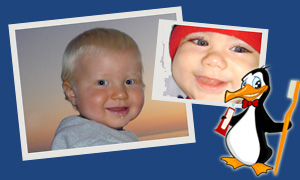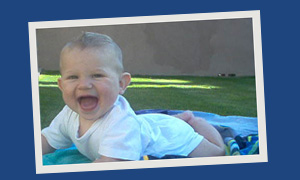
The American Academy of Pediatric Dentistry, American Dental Association and American Academy of Pediatrics all agree that children should begin to visit the pediatric dentist no later than their first birthday. Although this might seem young, it is extremely important that newly erupted primary teeth receive proper dental care from the very beginning.
Initial appointments are primarily used to help educate parents on proper cleaning methods, to discuss nutritional information, to create a plan in case of future dental trauma, and simply to begin familiarizing children with the dentist and dental office.
|
 |
It’s been shown that non-threatening visits at an early age also help to build a child’s confidence, provides a foundation for hygiene awareness and begins to create a caregiver – patient relationship.
During your first visit to West Valley Pediatric Dentistry, you and your child will become familiar with our office, staff & methods. We will make a great effort to ensure that your child feels comfortable in this new environment. Our doctors and staff will encourage parents to accompany their children into the examination bay during this initial visit. This introduces parents to our treatment environment, allows the attending doctor to discuss his/her initial dental findings, and provides parents with a general idea of our office’s philosophy. Depending upon your child’s response during this initial visit, the attending doctor will provide recommendations for following visits. If you are asked to accompany your child into the treatment area during subsequent visits, we suggest that you act as a “silent & supportive” observer only. It is very important for us to establish cooperation and trust directly with each patient. In turn, this will help your child begin to form a long lasting relationship with our staff and doctors, which should precipitate a positive outlook on dentistry.
Once the attending doctor has established his/her findings, he/she will review them with the accompanying parent or legal guardian. Our doctors encourage parents to take an active roll in deciding which treatment options are best for each individual child and will rely on your input. After treatment options have been thoroughly explored, you will receive a detailed treatment plan, which includes all recommended treatments, costs and insurance information. A Treatment & Financial Coordinator will then carefully review this information in detail and will explain how your specific dental insurance benefits work. Lastly, all payment options will be explored, an appointment will be scheduled and any final treatment questions will be answered.
For young children presenting to our office for their very first dental experience, parents can expect their child to show outward signs of anxiety stemming from a new and unknown surrounding. During this visit we may encourage your child to take radiographs, complete a dental cleaning, and apply professional topical fluoride. Completion of all these tasks is greatly dependant upon your child’s cooperativeness, acuteness & degree of visible dental decay, and your underlying comfort level. You can expect that your child will be fussy and somewhat defiant as we explore their mouths. Because this may be the very first time a stranger has invaded their oral personal space, young children tend to become anxious.
 |
Typically this visit is completed with your child sitting your lap while facing you. The doctor or staff member will sit with their knees touching yours, while your child lies back onto their lap. This position is known as a “lap examination” and allows for the young child to remain in direct contact with their parent, while providing a prone position for the caregiver to easily evaluate the oral cavity. We also recommend that this position be used when brushing and flossing their teeth during daily homecare. |
During the lap examination, the dental assistant may request that you hold your child’s hands to prevent injury secondary to grabbing a dental instrument. It is extremely important to remember that nothing during this visit will cause pain to your child. Again, we expect your child to be fussy during most of their first visit while they begin to become familiar with this new environment. Forcing a fussy child to complete these non-invasive visits semi-annually will quickly allow them to develop confidence and an overall understanding of what to expect during these visits. After 3-4 visits, typically their anxiety resolves and they normally are able to sit in the dental chair unassisted. Parents who stop a visit because they themselves become upset secondary to seeing their child defiant and/or crying, need to understand that this, in turn, negatively reinforces the event. Normally the take away message the child receives is, “if I act in a defiant manner, my mother will save me and get me out of the stressful situation.” Ultimately, this will have a negative effect on your child’s ability to cope with a situation that he/she is expected to manage at least twice a year for the rest of their life. We ask that our parents understand that as pediatric dentists, we have received extensive training in pediatric development and child psychology among other areas which provides us with great insight on a child’s behavior. We ask that parents understand that we have worked with thousands of children and have been confronted with every type personality possible. We will not expect children to act more mature than their actual age; however we do expect patient’s to exhibit age appropriate coping skills. Should you not be completely comfortable with the management of a particular situation, we always appreciate your understanding and desire your input. Please always feel free to discuss openly the management of your child. We truly want what is best for all our patients.
To help prepare your child for their first dental visit:
- Always speak positively about the upcoming visit and regarding the dentist in general. Children are like sponges and pick up on negativity. Hearing parents, siblings and friends speak negatively, even the slightest comments, will make this initial and future visits more difficult. Positive role modeling is considered the most important facet to ensuring a positive visit.
- Children love dramatic play. Practice counting your child’s teeth and let them know that the dentist will do the same. Allow your child to pretend they are the dentist examining and working on your teeth. Practice opening wide for the dentist. Use props such as toothbrushes, mirrors or even spoons.
- Give your child information to prepare for the dental visit and to help quiet their fears, but keep it simple. Too much detailed information may be overwhelming and will only increase their anxiety.
- Let your child know that the dentist will use a mirror and counting instrument to examine their teeth.
- Introduce the following word to your child when speaking about the dentist.
- Sugar Bugs = Cavities
- Sleepy Juice = Local Anesthesia
- Sleeping = Numb
- Fat, Itchy = Numb
- Bugs = Plaque, Calculus
- Goofy Gas = Nitrous Oxide
- Wiggle-Out = Extraction
- Never use any of the following words, as these tend to illicit fear in a child.
- Pain, Hurt
- Pull
- Needle, Shot
- Scared
- Blood, Bleeding
- Crying
- Explain that it is “fun” to visit the dentist and have your teeth checked and cleaned.
- Let your child know that they will receive a special prize from the dentist for cooperating at this visit.
- Read your child a story about visiting the dentist. There are many excellent options, including:
- The Berestain Bears Visit the Dentist; by Stan Berestain; Random House, 1981
- Joey Goes to the Dentist; by Jessica Kingsley; Jessica Kingsley Publishers, 2007
- A Day ay the Dentist; by Health Adamson, Capstone Press, 2004
- Caillou at the Dentist; by Johanne Mercier; Chouette, 2004
- Dental Office; by Lola Schaefer; Heinemann Library, 2000
- First Visit to the Dentist; by Monica Hughes; Raintree, 2004
- Going to the Dentist; by Melinda Randabaugh; Hinemann Library, 2004
- Open Wide!; by Tom Barber; Chrysalis Children’s Books/Publishers Group West, 2004
- Open Wide!, A Visit to the Dentist; by Cecile Schoberle; Simon, 2000
- Taking Care of You Teeth; by Sylvia Goulding; Rourke Publishers, 2005
- What Does A Dentist Do?; by Heather Miller; Enslow Publishers, 2005
- Where Do Baby Teeth Go?; Denise Jenkins; First Page, 2004
- Show Me Your Smile: Dora Visits the Dentist; by Christine Ricci; Simon & Schuster, 2005
- What to Expect When You Go to the Dentist; by Heidi Murkoff; 2002
- Just Going to the Dentist; Mercer Mayer; Yankee Publishing, 2001
- Danny Goes to the Dentist; Robert Robinson; McGraw-Hill, 2003
10. Set up a field trip to visit the dental office. West Valley Pediatric Dentistry hosts many after hour’s field trips for parent groups, PTA’s, summer day camps, and lots of other associations. Contact us to set up a non-threatening group visit to one of our West Valley offices.
We ask all our parents to feel free to contact our office at (623) 935-WVPD during normal business hours to ask any questions regarding an anticipated visit or simply with a general dental question. Our doctors or an educated staff member will always be happy to answer any of your questions!
|